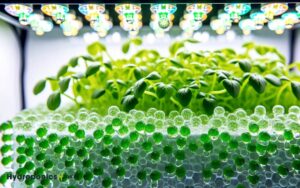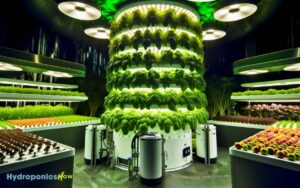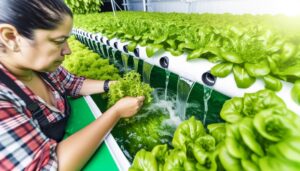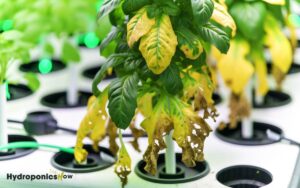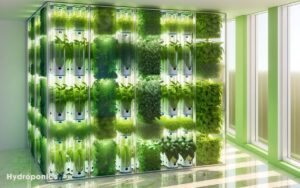Do Cats Get Into Hydroponic Plants?
Yes, cats do get into hydroponic plants. They’re naturally curious and drawn to the texture, smell, and movement of plants, simulating their hunting instincts. This behavior can lead to plant damage, nutrient loss, and contamination.
Some hydroponic plants are even toxic to cats, posing significant ingestion risks. To maintain both your cats and plants safe, opt for non-toxic varieties like basil and spider plants.
You should also use protective barriers and create cat-proof areas. Regular monitoring and adjustments can help uphold a safe environment. Want to guarantee harmony between your feline friend and your green thumb?
Learn more about effective strategies.
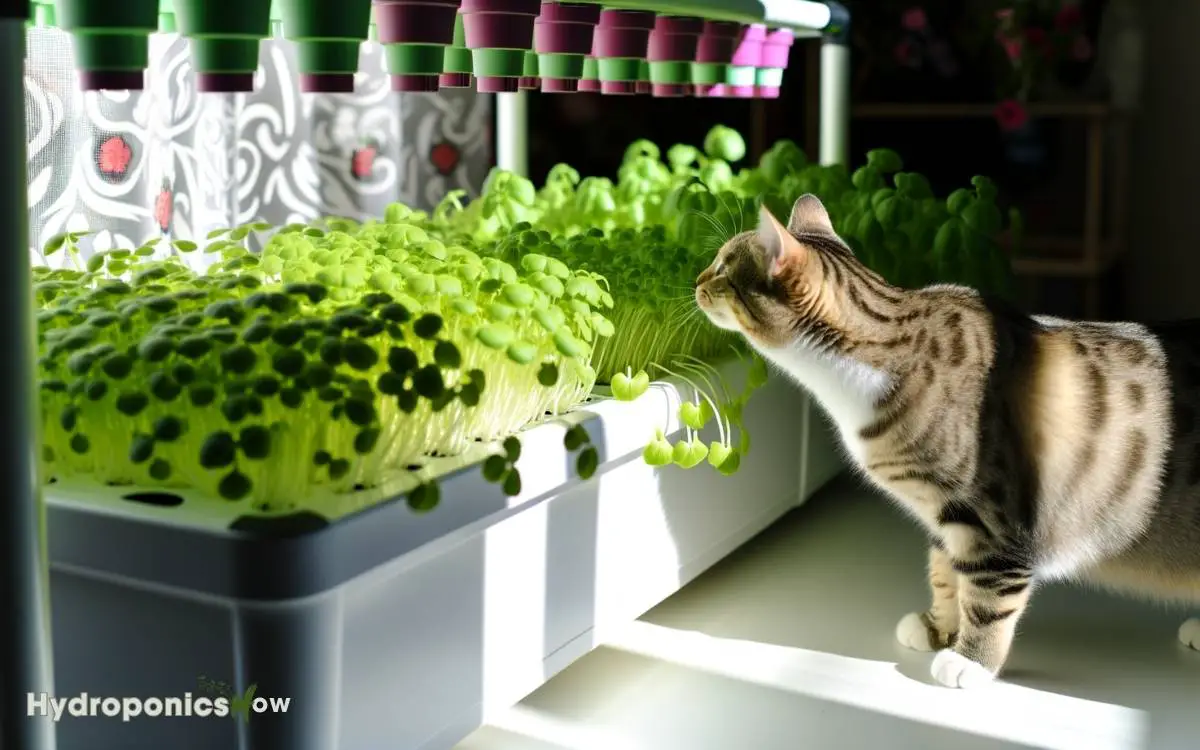
Key Takeaways
Cats’ Attraction to Plants
Cats’ attraction to plants often stems from their innate curiosity and sensory stimulation. You’ll notice that cats are naturally drawn to the texture, movement, and smell of plants.
Their highly developed sense of smell makes the aromatic compounds in plants particularly enticing.
Additionally, the swaying of leaves can mimic the motion of prey, triggering their hunting instincts. When cats explore plants, it’s not just about the smell or movement; the sensory experience of chewing on leaves or batting at stems can be satisfying.
This behavior is deeply rooted in their predatory nature and provides both mental and physical stimulation.
Understanding this can help you manage their interactions with your hydroponic garden, ensuring both your plants and your feline friend remain safe.
Risks to Hydroponic Gardens
When thinking about the risks to your hydroponic garden, it’s essential to address plant damage concerns, toxicity risks, and contamination issues.
Cats can easily topple plants, causing mechanical damage and disrupting growth. Additionally, their fur and waste can introduce harmful contaminants and potential toxins into the nutrient solution, jeopardizing plant health.
Plant Damage Concerns
Understanding the potential risks to your hydroponic garden from plant damage is essential for maintaining a healthy and productive system.
Cats can cause various types of physical damage to your plants. They might chew on leaves, dig into the growing medium, or knock over delicate structures.
Such activities can lead to nutrient imbalances, disrupted growth cycles, and potential crop loss. Monitoring your hydroponic setup and taking preventive measures can help mitigate these risks.
| Risk Type | Description | Potential Consequences |
|---|---|---|
| Chewing Leaves | Cats chewing on leaves | Nutrient loss, plant stress |
| Digging | Cats digging in the growing medium | Root damage, plant instability |
| Knocking Over | Cats knocking over structures | Physical plant damage, system leaks |
| Scratching | Cats scratching plant stems | Stem damage, reduced plant vigor |
| Urination | Cats urinating in the system | Contamination, nutrient imbalances |
Being proactive can guarantee your hydroponic garden thrives despite these challenges.
Toxicity Risks
Ensuring the safety of your hydroponic garden involves recognizing the toxicity risks that certain plants and substances can pose to both your crops and household pets. Some common hydroponic plants, like tomatoes and certain herbs, can be toxic to cats if ingested.
Additionally, the nutrients and chemicals used in hydroponic systems, including fertilizers and pH adjusters, pose ingestion hazards.
Cats are curious by nature and may interact with these substances, leading to potential poisoning. It’s important to research each plant’s toxicity and make sure that any chemicals are stored securely and used properly.
Consider using barriers or deterrents to keep your pets away from the hydroponic setup, thereby safeguarding both your plants and your furry friends.
Contamination Issues
Contamination in hydroponic gardens can arise from multiple sources, including water quality, pathogens, and cross-contamination from tools or other plants.
You must monitor water quality closely, ensuring it’s free from harmful chemicals and microorganisms.
Pathogens like bacteria, fungi, and viruses can infiltrate your system through infected plants or external sources. Keep an eye on plant health and promptly remove any diseased specimens.
Tools can also transfer contaminants if not properly sterilized between uses. Regularly clean and disinfect all gardening implements.
Additionally, pets such as cats can introduce dirt and pathogens, posing a risk to your hydroponic setup. Prevent their access to maintain a sterile environment.
Vigilant practices will help you maintain a healthy, productive hydroponic garden.
Common Cat Behaviors
Cats exhibit a range of common behaviors that are instinctual and serve various purposes for their wellbeing. Understanding these behaviors can help you create a more cat-friendly environment, especially when dealing with hydroponic plants.
- Scratching: Cats scratch to mark their territory and maintain their claws. This behavior is essential for their physical health and mental stimulation.
- Grooming: Grooming helps cats regulate their body temperature, remove parasites, and strengthen social bonds when performed in groups.
- Pouncing: This hunting instinct is crucial for their predatory nature and provides both physical exercise and mental stimulation.
Cat-Safe Plant Choices
Selecting the appropriate hydroponic plants is crucial to guarantee they’re safe for your feline companions.
Opt for non-toxic varieties such as basil, thyme, and spider plants. These plants not only thrive in hydroponic systems but are also harmless if ingested by cats.
Avoid plants like lilies and philodendrons, which are toxic to cats and can cause severe health issues.
Research extensively to confirm the safety of each plant species you introduce into your hydroponic setup. Also, make sure that any fertilizers or additives used are non-toxic and cat-friendly. Additionally, consider how hydroponic plants grow and ensure they receive proper nutrients without compromising the health of your pets. Regularly monitor your system for any signs of mold or harmful bacteria that could negatively impact both plant and animal well-being. By taking these precautions, you can create a thriving, pet-safe hydroponic environment.
Protective Barriers
Guaranteeing the safety of your hydroponic plants from curious feline paws often requires the implementation of effective protective barriers. A scientific approach guarantees both plant and pet safety.
Consider these options:
- Physical Barriers: Use mesh screens or plastic covers to create a physical separation. Ensure they’re sturdy enough to withstand a cat’s persistent attempts.
- Plant Enclosures: Enclose your hydroponic setup within a dedicated, cat-proof area. This could be a room with a door or a specially designed cabinet with ventilation.
- Elevated Platforms: Place hydroponic systems on high shelves or suspended platforms. Cats are agile, so ensure these heights are beyond their reach and the platforms are secure to prevent tipping.
Implementing these barriers can help safeguard your hydroponic plants effectively.
Training Techniques
To successfully train your cat to coexist with hydroponic plants, you’ll need to employ positive reinforcement strategies, establish consistent boundaries, and use diversionary tactics.
Reward your cat with treats or affection when they exhibit desired behaviors around the plants. Additionally, set clear limits on where your cat can roam and provide alternative attractions like cat grass or toys to keep them engaged.
Positive Reinforcement Strategies
Training your cat to respect hydroponic plants can effectively be achieved using positive reinforcement strategies. These techniques rely on rewarding desirable behavior rather than punishing unwanted actions.
Here’s how you can apply this method:
- Treats: Offer your cat a small treat when they stay away from the hydroponic system. This creates a positive association with ignoring the plants.
- Clicker Training: Use a clicker to mark the exact moment your cat behaves appropriately, followed by a reward. This reinforces the desired action.
- Affection: Praise and pet your cat when they demonstrate good behavior. Physical affection can be just as effective as treats.
Establishing Consistent Boundaries
Building on positive reinforcement strategies, establishing consistent boundaries is vital for teaching your cat to coexist harmoniously with your hydroponic plants.
Start by designating specific areas that are strictly off-limits. Use physical barriers like plant covers or mesh guards to clearly demarcate these zones.
Consistency is essential; guarantee every household member enforces the same rules. When your cat approaches the plants, gently redirect them and reward their compliance with treats or affection.
Utilize verbal cues like a firm ‘no’ to reinforce boundaries. Over time, your cat will associate these cues with restricted areas.
Regular monitoring is essential to ensure boundary adherence and to adjust strategies as needed. This method promotes a structured environment, reducing plant-related disturbances.
Diversionary Tactics for Cats
Engaging your cat with a variety of diversionary activities can effectively redirect their curiosity away from your hydroponic plants. Implementing structured training techniques helps in maintaining a harmonious environment.
Here are three effective tactics:
- Interactive Toys: Invest in puzzle feeders or electronic toys that stimulate your cat’s mind and keep them occupied for extended periods.
- Cat Grass: Provide safe, cat-friendly plants like wheatgrass or catnip. These can satisfy their natural urge to nibble on greenery.
- Dedicated Playtime: Allocate specific times each day for active play sessions using wand toys or laser pointers. This not only tires them out but also strengthens your bond.
Focusing on these strategies will keep your feline friend engaged and your hydroponic setup safe.
Alternative Cat Distractions
To keep your cats away from hydroponic plants, consider providing a variety of stimulating toys and activities that mimic natural hunting behaviors.
Interactive toys like laser pointers, feather wands, and puzzle feeders can engage their predatory instincts. Rotating these toys regularly prevents boredom. Additionally, offer scratching posts and climbing structures to satisfy their need for physical activity.
Catnip-infused toys can also provide sensory stimulation. Another effective strategy is creating a designated play area with these distractions, drawing their attention away from your plants.
By enriching your cat’s environment, you reduce their curiosity and potential interference with hydroponic systems.
These alternatives cater to their instinctual needs, ensuring they stay entertained and less likely to disrupt your plant setup.
Monitoring and Adjustment
While providing alternative distractions for your cat is beneficial, it’s equally important to regularly monitor and adjust the environment around your hydroponic plants to guarantee their safety and health. You’ll need to make sure your hydroponic setup remains cat-proof and your plants thrive.
Here are three essential steps to follow:
- Frequent Inspections: Regularly check your setup for signs of tampering or damage caused by your cat. Look for loose wires, disturbed plants, or spilled water.
- Adjust Barriers: Modify or strengthen barriers to keep your cat away from the hydroponic area. Consider using taller gates or more secure enclosures.
- Environmental Conditions: Monitor and adjust the light, temperature, and humidity around your plants to ensure ideal growth and deter cat interference.
Conclusion
In the end, an ounce of prevention is worth a pound of cure. By understanding your cat’s attraction to plants and the risks to your hydroponic garden, you can take proactive steps to protect both.
Use cat-safe plants, install protective barriers, and employ training techniques. Distract your feline friend with alternative activities and regularly monitor your setup.
With these strategies, you’ll create a harmonious environment for your hydroponic garden and your curious cat.

